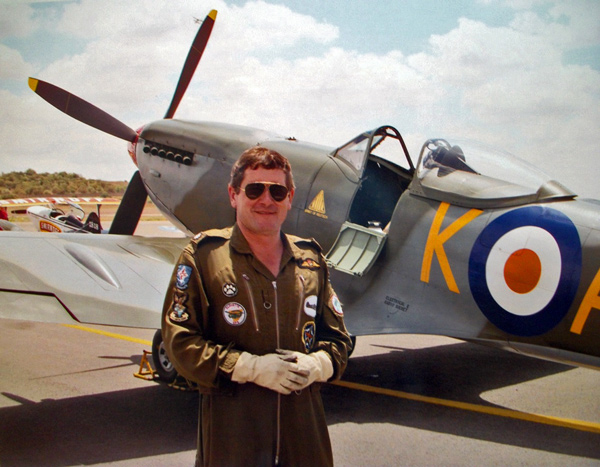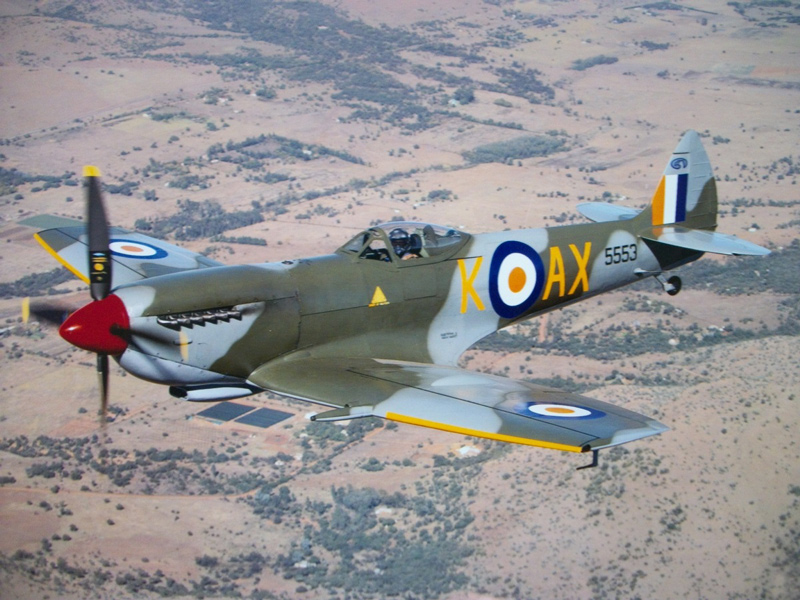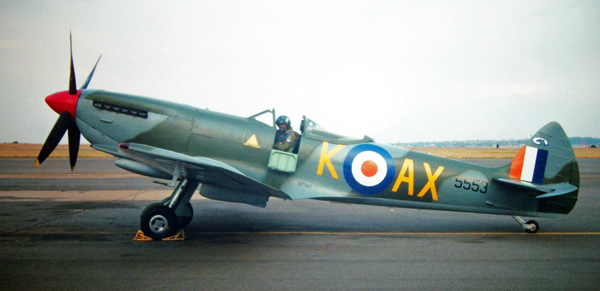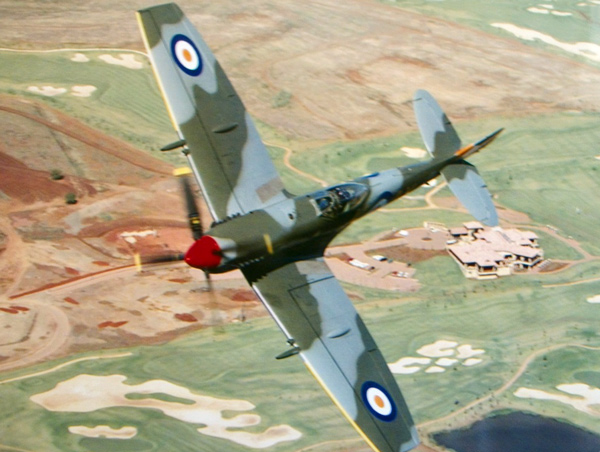|
Flying the Spitfire Mk. IX LF Here are my thoughts on flying the Spitfire MkIX of the South African Air Force Museum historic flight when posted to the SAAF Museum in 1999. * * * * * The South African Air Force Museum's example was a Spitfire Mk. IX LF, otherwise called the Spitfire Mk. XVI when fitted with a Packard-built Merlin engine. The aircraft is basically a Mk. IX with the teardrop-type canopy and the "clipped" wing tips, which many Spitfires had during the war. The clipped wing tips gave a better roll rate up to approximately 20,000 feet, although at those sorts of altitudes, rate of turn was reduced compared to the full elliptical wing. Most Spitfires used in a ground attack role had the clipped tips for better low level manoeuvrability. The clipped tips are workmanlike, but not as beautiful as the full elliptical wing, in my view. The "teardrop" canopy is interesting, as the canopy was tried out early in the war, and received very favourable comments from test pilots as to its allowing for much better all round view from the cockpit. However, for some reason it wasn't adopted until near the end of the war. Some people, like the iconic Duxford commentator and ex-WWII Spitfire XVI pilot Raymond Baxter, say this mark of Spitfire was the ultimate, as it still had the great handling of the Mk. IX, with the improved bubble canopy and the high rate of roll with the clipped tips. It was thought by many pilots that after the Mk. IX, the Spit started to get a bit too powerful and too heavy, causing some of the sweet handling characteristics to be lost. I think Alex Henshaw, the famous Supermarine test pilot, felt so. However, Jeffry Quill, another famous Spitfire test pilot, found he actually favoured the hairy-chested Mk. XIV. Our Spit was built at Castle Bromwich in 1945, and was part of a donation of 136 Spitfires given to the SAAF after the war for pilot weapons and air combat training. The SAAF Spits were used for weapons training, flying from Langebaanweg, to train pilots who went to the Korean War to fly Mustangs -- and later, F86 Sabres. The Spitfires were finally withdrawn from SAAF service in 1954. As to flying the aircraft, well, what can I say? There are so many clichés, like “you become a part of the machine,” or “you just think of turning and it turns.” “The aircraft becomes an extension of your own arms and legs” is another. Having flown the aircraft, I can only say those clichés are true. To fly the Spitfire was the chance of a lifetime for me, having always been a diehard Spitfire and WWII aircraft enthusiast and modeler from an early age. In this description, I will try to tell of technical quirks and details of the Spitfire -- details that I have not normally seen in articles on the Spitfire. You don't sleep much the night before your first flight! Our aircraft always started easily if primed correctly. I recall, whilst looking out over the nose on starting, as the prop slowly turned on the starter motor, how huge the propeller blades looked. As she cranked, you also watched for an over-prime by looking for flames along the exhausts. If this happened, you needed to keep the starter going. I over-primed it only once, and spent an anxious few moments watching a horrible amount of fire dancing about the cowlings until she fired up, instantly blowing the flames away. I was used to clouds of smoke and a deep gentle burble of the Harvard on start up. The Merlin, if primed correctly, suddenly settles to an idle, sounding like a 1960’s V12 Formula one race car -- a sort of crackle. At idle you can hear the clatter of the propeller reduction gearbox. Always a thrill.
The aircraft has no steerable tailwheel and turns are done by using full rudder and differential braking. The brakes are air operated, and are unheard with the engine running. However, if used on the ground with the engine off, a loud hissing is heard which sounds like mad Green Mambas. The brakes are also controlled by a little bicycle-type lever on the control column spade grip. It sounds strange, but it works quite well. Brakes, flaps and radiator shutters are powered by compressed air. A small compressor, driven by the camshaft at the rear of the left-hand cylinder bank pressurizes the system. The parking brake is applied by squeezing the lever then applying a little catch at the rear of the spade grip, locking the lever in place. Nice and easy. After a gentle power check (open the throttle too much on the ground, and she can go over on her nose) of Left and Right mag switches and a quick cycle of the propeller pitch, allowing the revs to not fall below 1800 RPM, you are ready to go. The aircraft is actually quite simple and there are not a lot of systems to check. It is important to have the radiators set fully open, and rudder trim set fully nose right! On the runway, you can tilt your head sideways with the canopy open and see quite adequately past the long nose. Opening the throttle, the aircraft accelerates very quickly, even at only +6 to +8 pounds/Sq. inch of boost, which is just over half throttle. War Emergency boost would go to about +18 boost. You have good directional and pitch control due to the slipstream over the tail. A tiny forward pressure on the stick gets the tail just off the ground, and the propeller spinner is easily held on the horizon. You can actually see a little of the top of the spinner from the cockpit and this is easily held on the horizon during the takeoff. Maintain this attitude and at 100 MPH, she lifts very smoothly off the ground. The undercarriage is now raised by moving the U/C lever down and out of the gate and holding it for a short pause to ensure the hydraulic system is pressurised. (When the lever is in the gate, either up or down, the system is at idle and is not pressurised by the engine driven pump). This is a bit tricky, as moving the lever too soon or too fast can leave you with a partial retraction and with an undercarriage leg blocking the radiator intakes! Luckily this happened to me only once. The cure is to take the lever out the gate, hold it against the “up” position. This should cause the gear to re-energise, continuing the “up” cycle. Small metal hoops are visible, located 2/3 of the way up the U/C legs. These engage in locking pins which have an angled end, and are rotated by small cables and chains attached to the gear selector quadrant. The pins rotate so the angled face of the locking pins is presented to the travelling gear in the correct sense. They are then pushed back by the cycling U/C legs, snapping back into place, to lock the gear. These chains and cables, also visible in the wheel bay, are checked carefully on a pre-flight. If one broke, the locking pin would not rotate and you would have no way of getting that gear leg down. To raise the U/C, you also experience your first taste if infamous British aircraft ergonomics! The U/C selector lever is on the right side of the cockpit, so you have to change hands on the stick. You will soon learn if you’ve forgotten to set the throttle friction because if not, it will instantly close at this point, to idle, at a critical stage of the takeoff! As the Spit accelerates further, coolant radiators are set to automatic and the canopy is closed, and then you notice a rapidly growing pressure on your left leg as you try to counter that full right rudder trim setting! A few turns of the highly-geared small rudder trim wheel sorts that out. I once decided to leave the rudder trim to see if I could override it in the event of a trim failure. The rudder pedal pressure built up rapidly against my braced leg, pushing me up the seat despite a tight harness. I very quickly wound the trim off!
Finally, you start to get your breath back and you can now devote more attention to how the aircraft flies. I remember watching a video on the Battle of Britain, and in the video a wartime Spit pilot, Pete Brothers, said the Spitfire seemed to read your mind and turn and do things without you seeming to actually do it with the stick. At the time I thought these were the quaint reminisces of an old warhorse, but after flying the aircraft I realised he was dead right. You do just "think of turning,” and she does it. Basically, the Spitfire has no vices, and it really is very pleasant and easy to fly. The controls are so light and powerful that it feels as though your hand is hardly moving on the stick if you throw the aircraft around. I am quite convinced that is why the Spit was so good in combat, as you can fly it to the limits all day without your arm getting tired. Even at speed, you can hold it in a max rate turn on the light buffet, with a gentle two-fingered pull in the stick. As a comparison, at the end of my instructor’s course in the SAAF, we practised aerobatics in a Harvard for a few days in a row, for the end-of-course aerobatics competition. After a few days my arm was sore! You think you are maintaining a pressure on the stick, but involuntarily, your arm relaxes. Remember this was also in a Harvard, which handled pretty well compared to most general aviation aircraft. This is one reason the Spitfire was considered effortless to fly. The "broken" stick (only the top part moves for roll control) also works well, as your arm is not moving all over the cockpit. With the clipped tips the roll rate is brilliant. My display routine involved a pass down the crowd line at about 300 feet AGL, where I would do a straight roll. With a ghost of an upward pitch, check, and stick hard over, she rolled rapidly through 360 degrees. Out front the nose stayed planted, rolling on the reference point with no yaw divergence.
I’ve mentioned the rudder earlier, but to add, it is
extremely powerful indeed and requires very little use once she’s up and
running. Both elevator and rudder trim are powerful and require small trim
wheel movements to adjust. The rudder trim is a smaller wheel then the
elevator trim wheel, which is slightly lower and further back.
In flight it is quite a sight to look out over that long, elegant nose. The
downward view is poor, as you are sitting almost directly above that broad
elliptical wing. Once, on an approach to Waterkloof, I was undershooting,
plus the Rate of Descent had increased, which had all been slightly masked
by those broad wings. I remember being a little surprised at the amount of
throttle I needed to correct that. Now comes the only
tricky part about flying the Spitfire. After lowering the tail to the
ground, you have to be positive and quick with rudder inputs, as with no
steerable tail wheel and no slipstream over the rudder (throttle closed),
you have to be positive on the rudder to keep her straight. With that narrow
track undercarriage, any swing must be stopped quickly, or it could fast
develop into a ground loop. I never landed in a heavy crosswind, and I’m
glad! *
* * * *  |



